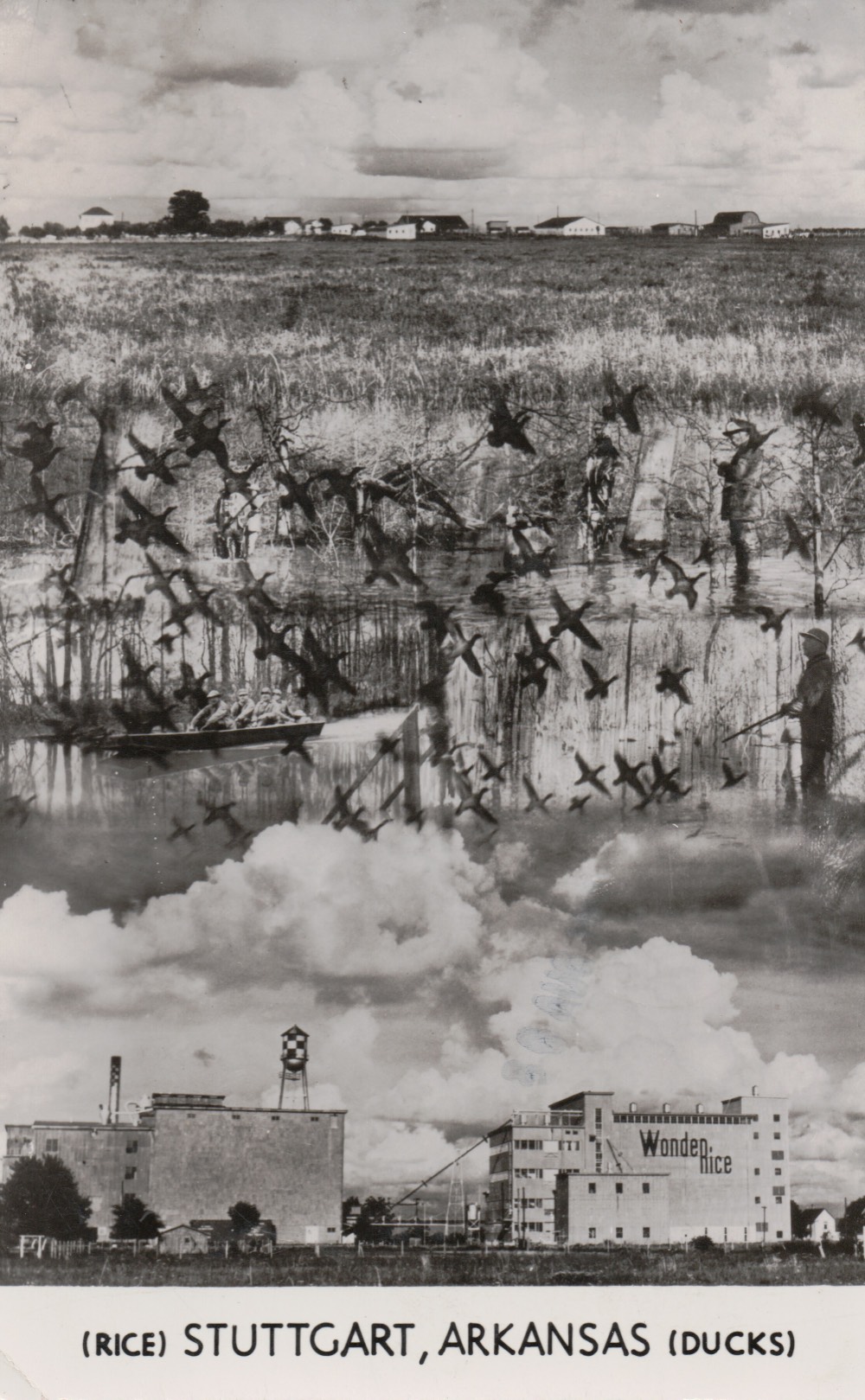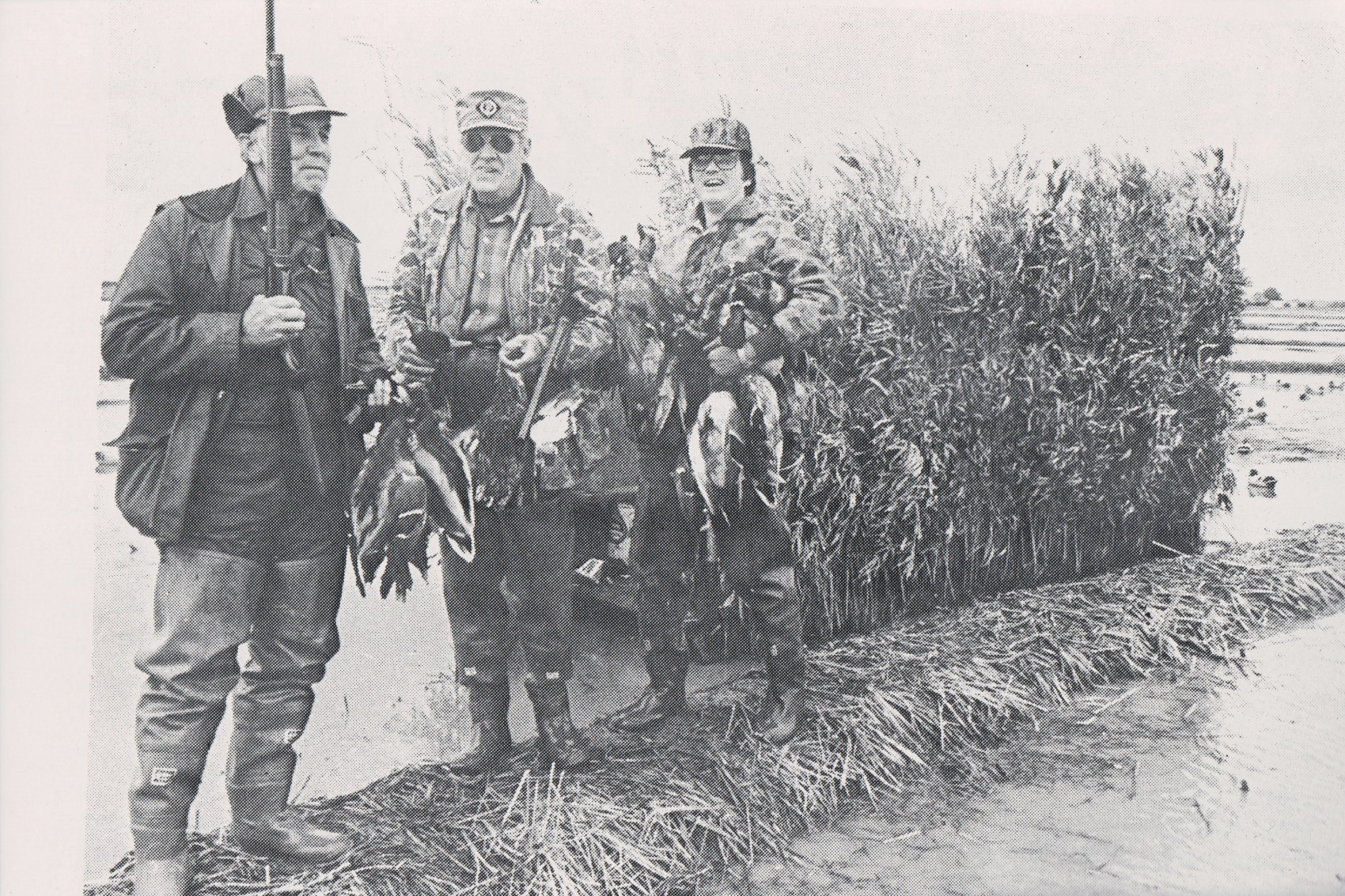Written by Brent Birch. The following is an excerpt from his book "The Grand Prairie: A History of Duck Hunting's Hallowed Ground"
Although mallards had been descending on the bottomland hardwoods, bayous, and swamps of Arkansas long before the 20th century, the legend of duck hunting in the natural states tends to coincide with the advent of rice farming. The famed Grand Prairie region of Arkansas with Stuttgart as the epicenter, began rice production took off with credit going to W.H. Fuller of Carlisle, Arkansas in the late 1800s and early 1900s.
As more rice was farmed in the state, the more ducks became a literal nuisance. Rice was harvested and bundled in the fields and waves of mallards would bombard the harvested crops eating everything in sight. Locals went through all kinds of efforts to shoo the ducks away including shooting them under the moonlight, sirens, and air control tower-type lights to chase off hungry ducks.
But as game laws tightened and limits downgraded from 25 a day to more manageable numbers, hunters became the key disruptors to keep the mallards off the rice fields between sunrise and sunset. By the 1940s, the word was out, and the duck hunting tourism boom took off for not only the famed green timber but also the wads of ducks coming to shallow rice fields looking for waste grain.
Ducks were so attracted to the rice fields in the mid-1950s that hunters could sit on levees in lawn chairs and shoot them like doves. As the ducks got smarter, hunters also evolved by hunting them from various blinds, including pit blinds sunk into the ground, layout blinds akin to low profile boats pulled into the rice stubble, and even hiding in the cattails and other brush growing along the ditch bank.
Rice field hunting isn’t quite what is used to be in the state due to changes in farming practices. Modern-day combines are more efficient leaving less waste grain and rice is harvested much earlier in the year than in the old days. But with the right combination of weather and available food, rice fields can still produce productive days afield.
The following is an excerpt from The Grand Prairie: A History of Duck Hunting’s Hallowed Ground on modern-day techniques used to hunt mallards in the flooded rice fields of Arkansas.

Shooting in rice fields on the Grand Prairie is almost as equally well-known as gunning the green timber. The combination of these two habitat types in such close proximity to each other has created a mecca for waterfowlers.
Growing rice proved to be an economic benefit for the settlers. It also proved to be a boon for waterfowl. Eastern Arkansas, especially the Grand Prairie, is famous for its rich duck-hunting tradition, much of which is due to rice production. Early hunters noted that populations of several waterfowl species, particularly mallard, pintail, and green-winged teal, grew significantly during the early 1900s, as flooded rice fields replaced the native prairie.
Before rice production came to the Grand Prairie, ducks were found foraging in the small prairie wetlands, seasonal herbaceous wetlands, and the vast bottomland hardwood forests of the White and Arkansas rivers. When rice arrived, a new and abundant food source became readily available.
Early rice fields contained lots of waste grain resulting from inefficient harvest machinery or manual labor. It is believed that as much as twenty to thirty percent of the early rice crops were lost on this account. Seeds from other plants growing in the fields were available as well. As a result, many waterfowl species moved from their historical foraging areas to rice fields to take advantage of this energy-rich food source. Reports from hunters and records from duck clubs confirm that waterfowl populations increased greatly during the early 1900s. Some believe they might have grown to all-time record numbers in the region through the 1920s.
However, by the mid-1900s duck populations on the Grand Prairie began to decline as rice harvesting became more efficient. According to Luke Naylor, AGFC waterfowl biologist, recent research has shown that rice fields in the Arkansas Delta contain only about seventy pounds of waste grain per acre when waterfowl arrive, and furthermore that ducks rarely feed in sites with less than fifty pounds per acre. Also contributing to the decrease in waterfowl numbers on the prairie were the loss of many acres of bottomland hardwood forests to clearing and the increase in hunting pressure.
Nonetheless, Ducks Unlimited believes that with the widespread loss of natural wetlands across the southern United States, many waterfowl, especially mallards and the majority of the continent's pintails, now rely heavily on flooded rice fields during the winter.
It should be no surprise then that flooded rice fields are excellent places to hunt waterfowl. Many rice producers receive significant extra income from leasing fields to hunters. This is especially true in the Stuttgart area. It has become profitable for rice farmers on the Grand Prairie to manage water for ducks, and many are doing an excellent job. They have discovered that re-flooding and rolling their rice fields after harvest not only attracts ducks and therefore hunter dollars, but it also aids in the decomposition of the remnant rice straw that formerly had to be burned or tilled under.
In order to be successful hunting flooded rice fields, hunters must be well hidden. Rice fields by nature occur in relatively level, open country with little vertical structure to break up the outline of an above-ground duck blind. Some hunters use stake- or skid-mounted blinds in the open rice fields, but most feel the ducks soon become wary of anything sticking up in an otherwise flat plain. The most successful rice-field hunters shoot from below-grade structures known as pits. These low-profile hides are generally located in a rice levee, or in the case of a zero-grade field, in a cross dyke. If well-placed and camouflaged, pits are practically invisible and very effective.
The size and construction of the pits are quite variable. The minimum length for four hunters is approximately twelve feet. Some, however, can accommodate up to ten gunners and may be as long as twenty feet. There is no standard width or depth; wider is more comfortable for the seated occupants, but narrower is more concealable. The depth must be sufficient to allow the hunters to stand and shoot comfortably and safely.
Most pits are fabricated from steel sheets welded together and suitably braced to withstand the external pressure from the backfill material. Some pits are crafted from recycled steel containers or tanks. Provisions must be made to overcome the buoyant force exerted when the field is flooded. Various methods are used to accomplish this, including screw anchors, concrete deadmen, and extended flanges bearing the weight of the backfill. Pit designs range from simple rectangular boxes accessed by crude ladders to more elaborate and creative models with step-up shooting platforms, built-in shelves, dog boxes, sumps, and stairs. Concealing the pit from above has produced some ingenious solutions. Various systems of fixed, hinged, and sliding tops are employed, each with its own set of advantages and disadvantages.
Grooming a rice field for hunting is subject to various preferences, as one might expect. During harvest, the combine leaves stubble, which can be dealt with in a number of ways. It may be left standing, mowed, rolled, burned, or disked under. Some hunters prefer to leave the stubble standing, believing the ducks like the security of the emergent cover. Others prefer to obliterate it, believing the birds prefer to land in open water. Most believe that a combination of these treatments produces optimum results. Typically they will roll the stubble in some pattern around the pit and leave the balance of the field untouched.

Kris Adkins, a Little Rock sales executive, admits to being obsessed with waterfowling. “I live to duck hunt," he remarked in an interview with Greenhead magazine. He hunts a 300-acre farm north of the settlement of Brummitt, about ten miles west of Stuttgart, that is owned by his father, Dennis. A ten-member hunt club named Feather Flats was organized in 1974 to lease the farm. Over the years, as people got out, they were not replaced. Dennis Adkins developed a great relationship with the landowner and told him to give him first shot at buying it if he ever wanted to sell. “Well he did!” reports Kris Adkins. “In 1993 he called dad and said he was ready. The price and terms were reasonable and, needless to say, he accepted! The rest is history. After we bought it we changed the name to ‘Feather Farms.’”
It is incredibly well-located. The famous 1,000-acre Hildebrand buckbrush reservoir is on the south. ABF’s corporate retreat property surrounds Feather Farms with a greentree reservoir on the southeast and with their buckbrush rest area on the east and north. Kris Adkins confirmed it is on the X. “The amount of ducks those two places hold at times would blow your mind. AGFC did a survey one time and said those two reservoirs were holding well over 100,000 ducks.”
Two hundred forty acres are devoted to agricultural production. In years past the Adkinses alternated rice and soybean crops among two fields. With the coming of Clearfield crop technology, they are now able to plant rice on both fields every year.
There is also a twenty-acre trophy bass lake on the property.
The Adkinses have only one blind on Feather Farms. It is a twenty-four-foot-long steel pit fabricated almost twenty years ago by a welder in Jonesboro. There are dog boxes on each end, which also serve as steps for entering and leaving. Rather than having a sliding top, they elected to go with hinged flaps for concealment from above. The pit is oriented along a north–south axis. By sliding a 2 x 10 seat board to either side, the hunters can shoot in either direction, east or west, depending on the wind and sun. The pit comfortably hunts six guns.
How they chose the location of the blind is interesting. In the beginning they hunted from a box blind located in a woody fence line along the south property line. Its limitation was that when the wind was in the north, the ducks could not clear the trees and hit the decoy spread in front of the blind. Rather they landed out in the middle. One day, after watching this for a couple hours, teenaged Kris Adkins had seen enough. He asked his dad if he and his buddy could take a bench out to a weedy drainage swale near where the ducks were landing and throw out a few decoys. Begrudgingly, Dennis Adkins gave in.
The young guns took the bench and three decoys apiece and to the swale and shot eight mallards and two pintails in less than thirty minutes. After retrieving the birds, Kris Adkins hollered back to his father, who had not fired a shot, “Do you want me to kill your limit?
“Hell no,” came the response, “I’m on my way.”
They hunted from the bench for a couple years before burying the pit in the low area in the rice field, near where the young men had shot that quick limit.
The Adkinses have somewhat of a revolutionary approach to hunting Feather Farms. First, rather than leaving or rolling the rice stubble, they mostly obliterate it by a succession of mowing, burning, and lightly disking the entire field. This does not, however, decrease the amount of waste rice available for the ducks. Second, they only flood a small portion of the 240-acre field. When asked if it was zero grade, Kris Adkins quickly replied, “Hell no! I wouldn’t have a zero grade field. I want to control exactly where the water is and precisely where the ducks land.” Surprisingly they accomplish this by only putting water on about twenty acres around the pit. Third, in order to overcome the starkness of the bare field and to make the pit blend in, they cut an enormous number of oak branches and place them on the pit and in a windrow extending seventy-five yards out from each end, mimicking a rice levee. They add four or five trailerloads every year.
Kris Adkins does not deny he is a “decoy freak.” His spread consists of about ten dozen decoys, mostly mallards, but other species such as pintails and shovelers are mixed in. He puts out both floaters and full-bodied standing birds. He typically buys new decoys every two years or so, and they are of the finest quality, with flocked heads and all. Their decoys are left out all the time, but they frequently change the patterns, even retiring some later in the season. They do not use spinning-wing decoys, as they do not believe they work anymore. They do employ a jerk string to ripple the water on calm days.
The Adkins and their guests hunt hard. They are in the pit almost every day during the season. Based on experience, they do not see the need for rest days or for morning-only hunting. They also work hard. As Kris Adkins put it, “We work our asses off to make it right. It's not timber where you just go add water and throw out decoys. There is a lot of work and preparation. Field hunting is a total different animal. The ducks can see everything and if it's not right, they're not gonna do it. I have watched ’em in that place for thirty-five years. Cover and making everything look natural is the biggest key … low profile pit with lots of cover, clean decoys, jerk strings, NO ROBO DUCKS, ankle deep, and no zero grade!”
Kris Adkins gives his father a lot of credit for the success at Feather Farms as well. “He is an avid hunter. He’ll hunt 55–58 days a year. He is eaten up with it! Like it is his life! He's like a kid in a candy store! The place is his baby!”
He added, “Another big key for us is dry weather. If the Cache and White rivers don’t flood, it is usually really good for us. I always tell people selfishly, I hope it doesn’t rain ’til February 1 every year.”
Does this unusual strategy work? Absolutely! On average they shoot one 1,000 ducks during a season, mostly mallards. During the record year they shot an amazing 1,502 ducks from the pit. They also harvest from seventy-five to one hundred white-fronted geese.
The Adkinses’ approach to hunting a rice field is rather unorthodox. Little Rock publishing executive Greg Churan employs more conventional tactics. Churan has been involved in rice-field and shallow-water moist-soil hunting leases across the length and breadth of the Grand Prairie for over twenty years. He has hunted fields south of Lodge Corner, east of Stuttgart, north of Humphrey, west of Des Arc, and several other spots east of the White River. These fields have run the gamut from large to small, from contoured to zero grade, and from rotated to a monoculture of rice every year. Over the years he has developed strong opinions about the best management practices and hunting strategies.
For mallards, Churan prefers to hunt contoured rice fields as opposed to those leveled to zero grade. He feels the structure of the rice levees makes it easier to hide. For white-fronted geese and some other ducks, such as green-winged teal, he prefers a zero grade field. He believes in leaving as much vegetation standing as possible on the levees but rolling the stubble in the pools. Churan cautions about flooding too early—just before the season is ideal—and too deep (ankle-deep is perfect). Regarding pits, his preferences vary from field to field, but in general those with roll tops are favored. This allows him to shoot either direction based on wind direction. He uses a Lab for retrieving, so a built-in box is desirable.
The subject of decoys is more complex. Churan says, “My set up on any given day is based on a number of factors, including as a minimum, wind, sun, and time of season. It’s all different. I think the larger the body of water, the more decoys you need. I’ll put out up to ten dozen in my spread early in the season. I believe mixing species is always a good idea. I usually leave a funnel-shaped open space in front of the pit as a landing zone. Although it’s a pain, and I don’t always do it, picking up decoys after each hunt is best. Some of the modern anchoring systems, like the Texas Rig, make it a little easier. Yes, I use mojos, particularly early in the season when I believe they work best. In any case I use a remote control so I can turn them on and off at key times. One more thing, I use fewer blocks in late season when the birds become decoy shy.”
Churan agrees with those who believe in resting a rice field but not according to a set schedule. He contends you must monitor bird usage, both numbers and time of day, as well as weather and potential migrations before establishing rest periods.
In conclusion, he says, “You can sometimes throw all the theory out the window. In my best year hunting a zero-grade rice field, the farmer had planted it in soybeans. Go figure!”



























